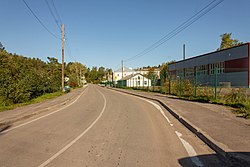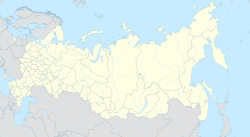
The Karelian Isthmus is the approximately 45–110-kilometre-wide (30–70 mi) stretch of land situated between the Gulf of Finland and Lake Ladoga in northwestern Russia, to the north of the River Neva. Its northwestern boundary is a line from the Bay of Vyborg to the westernmost point of Lake Ladoga, Pekonlahti. If the Karelian Isthmus is defined as the entire territory of present-day Saint Petersburg and Leningrad Oblast to the north of the Neva and also a tiny part of the Republic of Karelia, the area of the isthmus is about 15,000 km2 (5,800 sq mi).

Priozersk is a town and the administrative center of Priozersky District in Leningrad Oblast, Russia, located at the northwestern shore of Lake Ladoga, at the estuary of the northern armlet of the Vuoksi River on the Karelian Isthmus. It is served by a station of the same name on the St. Petersburg—Khiytola railway. Population: 18,777 (2021 Census); 18,933 (2010 Census); 20,506 (2002 Census); 20,557 (1989 Soviet census).

Martti Olavi Talvela was a Finnish operatic bass.

Kamennogorsk, is a town in Vyborgsky District of Leningrad Oblast, Russia, located on the Karelian Isthmus on the left bank of the Vuoksi River 170 kilometers (110 mi) northwest of St. Petersburg. Population: 6,739 (2010 Census); 6,084 (2002 Census); 5,694 (1989 Soviet census).

Primorsk is a coastal town in Vyborgsky District of Leningrad Oblast, Russia and is the second largest Russian port on the Baltic, after St. Petersburg. It is located on the Karelian Isthmus, 137 kilometers (85 mi) west of St. Petersburg, at the northern coast of the Gulf of Finland, near Beryozovye Islands which are protected as a sea bird sanctuary. Population: 6,119 (2010 Census); 5,332 (2002 Census); 6,637 (1989 Soviet census).
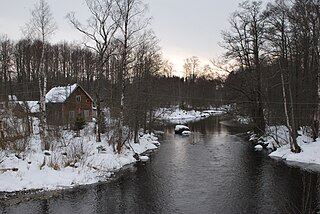
Priozersky District is an administrative and municipal district (raion), one of the seventeen in Leningrad Oblast, Russia. It is located in the northwest of the oblast and borders with Lakhdenpokhsky District of the Republic of Karelia in the north, Vsevolozhsky District in the south, and Vyborgsky District in the west. In the east, the district is bounded by Lake Ladoga. The area of the district is 3,597.5 square kilometers (1,389.0 sq mi). Its administrative center is the town of Priozersk. Population : 43,260 (2010 Census); 42,859 ; 40,231 (1989 Soviet census).

The Saint Petersburg–Hiitola railway is a 170-kilometer (110 mi) long railway with 1,520 mm broad gauge located in St. Petersburg, Leningrad Oblast and Republic of Karelia, which links Finlyandsky Rail Terminal to Khiytola through Devyatkino, Vaskelovo, Sosnovo, Priozersk and Kuznechnoye. Originally built by Finnish State Railways in the Grand Duchy of Finland, the railway was part of a trunk line from Vaasa by the Gulf of Botnia to St. Petersburg. In the 1940 Moscow Peace Treaty the territory was ceded by Finland to the Soviet Union. The railroad is now operated by the Russian Railways. The railroad is used by passenger trains between St. Petersburg and Sortavala. The track between Khiytola and Sortavala is a part of the Vyborg–Joensuu railroad completed in 1894.

Vyborgsky District is an administrative and municipal district (raion), one of the seventeen in Leningrad Oblast, Russia. It is located in the northwest of the oblast on the Karelian Isthmus and borders with Priozersky District in the northeast, Vsevolozhsky District in the east, Kurortny District of the federal city of St. Petersburg in the south, Kymenlaakso and South Karelia regions of Finland in the northwest, and Lakhdenpokhsky District of the Republic of Karelia in the north. From the southwest, the district is limited by the Gulf of Finland. The area of the district is 7,475.472 square kilometers (2,886.296 sq mi). Its administrative center is the town of Vyborg. Population : 120,446 (2010 Census); 113,748 ; 108,571 (1989 Soviet census).

The old Karelian railroad between Viipuri and Joensuu was a 1,524 mm broad gauge line that used to link Joensuu, Sortavala, Hiitola, Antrea and Viipuri. Originally built in 1892-1894 by Finnish State Railways in the Grand Duchy of Finland, in the 1940s most of the railway up to Niirala was ceded by Finland to the Soviet Union in the Moscow Peace Treaty, Moscow Armistice and Paris Peace Treaty as a result of the Winter War and Continuation War. Now the track is located in Leningrad Oblast, Republic of Karelia and North Karelia. The Sortavala–Joensuu link across the border was abolished after the Continuation War, but was since restored and is currently in use for cargo traffic.

Losevo is a rural locality in Priozersky District, Leningrad Oblast, located at the junction of Vuoksi River and Lake Sukhodolskoye on Karelian Isthmus. It is a railway station of the Saint Petersburg–Khiytola railroad. Before the Winter War and Continuation War, it was a village of the Sakkola municipality of Finland known as Kiviniemi.
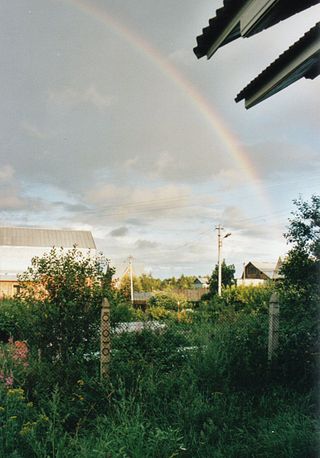
Beloostrov, from 1922 to World War II Krasnoostrov, is a municipal settlement in Kurortny District of the federal city of St. Petersburg, Russia, located on the Sestra River, Karelian Isthmus. Population: 2,080 (2010 Census); 1,690 (2002 Census); 1,405 (1989 Soviet census). The settlement has a railway station Beloostrov.

The Vammelsuu–Taipale line was a Finnish defensive line on the Karelian Isthmus built in 1942–1944 during the Continuation War and running from Vammelsuu on the northern shore of the Gulf of Finland through Kuuterselkä and Kivennapa and along Taipaleenjoki to Taipale on the western shore of Lake Ladoga. It crossed the Saint Petersburg–Vyborg railroad at Sahakylä and the Saint Petersburg–Hiitola railroad at Kelliö.

Viipuri Province was a historical province of Finland from 1812 to 1945.

The Riihimäki–Saint Petersburg railway is a 385-kilometre (239 mi) long segment of the Helsinki–Saint Petersburg connection, which is divided between Saint Petersburg and Leningrad Oblast in Russia and the province of Southern Finland in Finland.
The history of rail transport in Finland began on January 31, 1862, with the opening of the railway line between Helsinki and Hämeenlinna. By 1900 most of the future main lines had been constructed, including the line to St. Petersburg. By the time of the birth of the new Finnish Republic in 1917 lines connected all major cities, major ports, and reached as far as the Swedish border, and inner Finland as far north as Kontiomäki in Paltamo region, as well as eastwards into Karelia.

Vyborg is a town and the administrative center of Vyborgsky District in Leningrad Oblast, Russia. It lies on the Karelian Isthmus near the head of Vyborg Bay, 130 km northwest of St. Petersburg, 245 km east of the Finnish capital Helsinki, and 38 km south of Russia's border with Finland, where the Saimaa Canal enters the Gulf of Finland. The most recent census population of Vyborg is 72,530 (2021 Census).
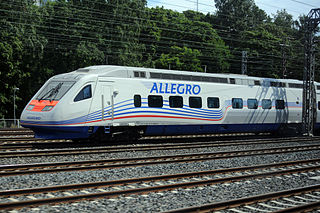
Allegro was the brand name of a now defunct high-speed train service, operated by Alstom VR Class Sm6 trains, between Helsinki, Finland, and St. Petersburg, Russia.

Vasily Seseman was a Russian and Lithuanian philosopher, a representative of Marburg school of neo-Kantianism. He is mostly remembered for his role in fostering philosophy in newly independent Lithuania and developing Lithuanian philosophical vocabulary. A close associate of Viktor Zhirmunsky and Lev Karsavin, as a prisoner of Gulag he was also an informal philosophy tutor and supporter of Buddhist writer Bidia Dandaron.

Peter von Sivers, more commonly known falsely as Peter von Sievers, was a German Admiral of the Imperial Russian Navy.

The Haukkavaara — Pekonlahti narrow-gauge railway was a 750 mm narrow gauge railway in use between 1898 and 1927 in the Khiytola parish. The railway was owned by a sawmill in Pekonlahti and was used mostly to transport finished products to a broad gauge railway station. Until 1918, it also transported passengers.
